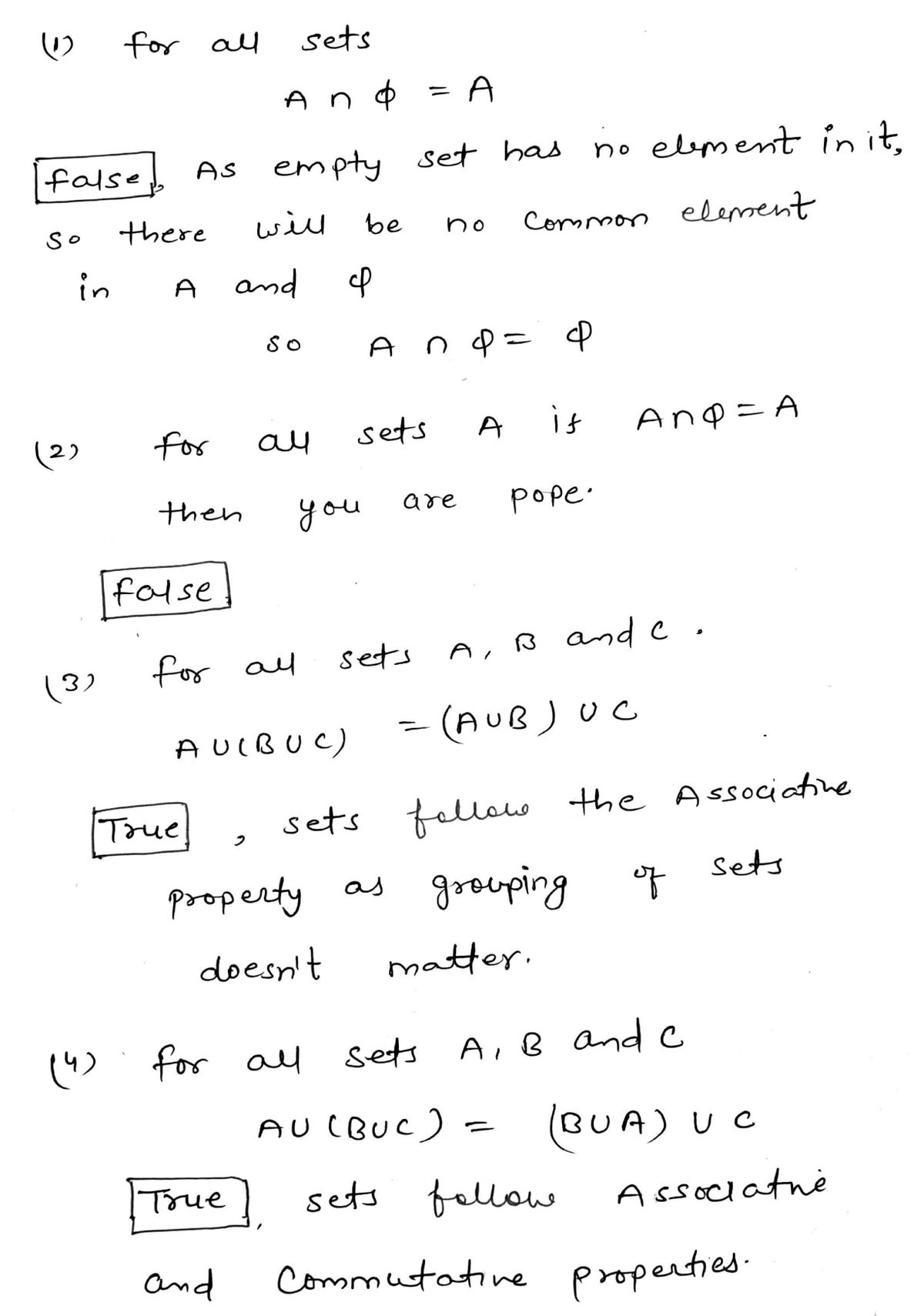T T T T T T F F F F F F F For all sets AN Q = A For all sets A, if AN q = A, then you are the pope. For all sets A, B, and C, A U (B U C) = (A U B) U C For all sets A, B, and C, A U (BU C) = (BU A) UC If x ¤ (AUB)º then x & A or x & B. If x = (ANB)c then x & A or x & B. = the universal set. φε
T T T T T T F F F F F F F For all sets AN Q = A For all sets A, if AN q = A, then you are the pope. For all sets A, B, and C, A U (B U C) = (A U B) U C For all sets A, B, and C, A U (BU C) = (BU A) UC If x ¤ (AUB)º then x & A or x & B. If x = (ANB)c then x & A or x & B. = the universal set. φε
Advanced Engineering Mathematics
10th Edition
ISBN:9780470458365
Author:Erwin Kreyszig
Publisher:Erwin Kreyszig
Chapter2: Second-order Linear Odes
Section: Chapter Questions
Problem 1RQ
Related questions
Question
100%

Transcribed Image Text:**Set Theory Statements and Analysis**
1. **True or False Analysis for Set Operations:**
- **Statement:** For all sets \(A \cap \varnothing = A\)
- **Truth Value:** True
- **Analysis:** The intersection of any set \(A\) with the empty set \(\varnothing\) is indeed \(A\).
2. **Statement:** For all sets \(A\), if \(A \cap \varnothing = A\), then you are the pope.
- **Truth Value:** False
- **Analysis:** This statement is humorous in nature and is logically false since there’s no correlation between set operation results and the identity of a person.
3. **Statement:** For all sets \(A, B, \) and \(C\), \(A \cup (B \cup C) = (A \cup B) \cup C\)
- **Truth Value:** True
- **Analysis:** This represents the associative property of union for sets.
4. **Statement:** For all sets \(A, B, \) and \(C\), \(A \cup (B \cup C) = (B \cup A) \cup C\)
- **Truth Value:** True
- **Analysis:** This is also valid due to the commutative and associative properties of union.
5. **Statement:** If \(x \in (A \cup B)^c\) then \(x \notin A\) or \(x \notin B\).
- **Truth Value:** True
- **Analysis:** If \(x\) is in the complement of \(A \cup B\), then it is not in either \(A\) or \(B\).
6. **Statement:** If \(x \in (A \cap B)^c\) then \(x \notin A\) or \(x \notin B\).
- **Truth Value:** False
- **Analysis:** If \(x\) is in the complement of \(A \cap B\), then \(x\) is not in both \(A\) and \(B\) at the same time, not necessarily 'or'.
7. **Statement:** \(\varphi^c = \text{the universal set.}\)
- **Truth Value:** True
- **Analysis:** The complement of the empty set \(\
Expert Solution
Step 1: True / false explanation

Step by step
Solved in 3 steps with 2 images

Recommended textbooks for you

Advanced Engineering Mathematics
Advanced Math
ISBN:
9780470458365
Author:
Erwin Kreyszig
Publisher:
Wiley, John & Sons, Incorporated

Numerical Methods for Engineers
Advanced Math
ISBN:
9780073397924
Author:
Steven C. Chapra Dr., Raymond P. Canale
Publisher:
McGraw-Hill Education

Introductory Mathematics for Engineering Applicat…
Advanced Math
ISBN:
9781118141809
Author:
Nathan Klingbeil
Publisher:
WILEY

Advanced Engineering Mathematics
Advanced Math
ISBN:
9780470458365
Author:
Erwin Kreyszig
Publisher:
Wiley, John & Sons, Incorporated

Numerical Methods for Engineers
Advanced Math
ISBN:
9780073397924
Author:
Steven C. Chapra Dr., Raymond P. Canale
Publisher:
McGraw-Hill Education

Introductory Mathematics for Engineering Applicat…
Advanced Math
ISBN:
9781118141809
Author:
Nathan Klingbeil
Publisher:
WILEY

Mathematics For Machine Technology
Advanced Math
ISBN:
9781337798310
Author:
Peterson, John.
Publisher:
Cengage Learning,

